· 9 min read
What the tree’s annual rings tell about its fate
One hundred years of solitude
Let’s start with the most simple thing, at first glance — age. The same as our heroine, fir trees (Picea obovata), standing alone on a bare hill somewhere in the wild north, often shyly hide their age. At first glance, thin and short trees turn out to be trees of quite respectable years. The fact is that trees in the north grow differently and it is not always possible to determine by size whether the fir tree in front of you is young or old. A tree that looks like a teenager often turns out to be a long-liver. The approximate age of a fir tree can be determined by simply counting its annual rings, and there is no need to cut it down to the very root: you can drill the trunk with an age drill to take a sample — a core.

Spruce wood core. From the center to the subcortical ring 246 years and only 11.3 centimeters
But to find out the exact age of a tree, it is worth taking a closer look at the pattern of alternating light and dark stripes on the resulting cut or core of the tree: some rings will be wider, some narrower. Uneven alternation of rings appears due to the difference in summer temperature from year to year. In a warm summer, all trees grow quickly, so the rings are relatively wide. And if the summer is cold, then all the rings are narrow, sometimes barely noticeable. The pattern of rings in trees growing in the same area is the same — after all, their growth conditions will be the same. Therefore, when a tree dies, or it is cut down for a holiday, you can superimpose its annual rings on the pattern of trees with a known date and find out, to the nearest year, when the tree was born and how many years it grew.
This superimposition of tree rings is called cross-dating. With its help, you can not only find out the exact time of life of an individual tree but also build very long chronologies. In Yamal, for example, the duration of such tree-ring chronology is 8768 years.
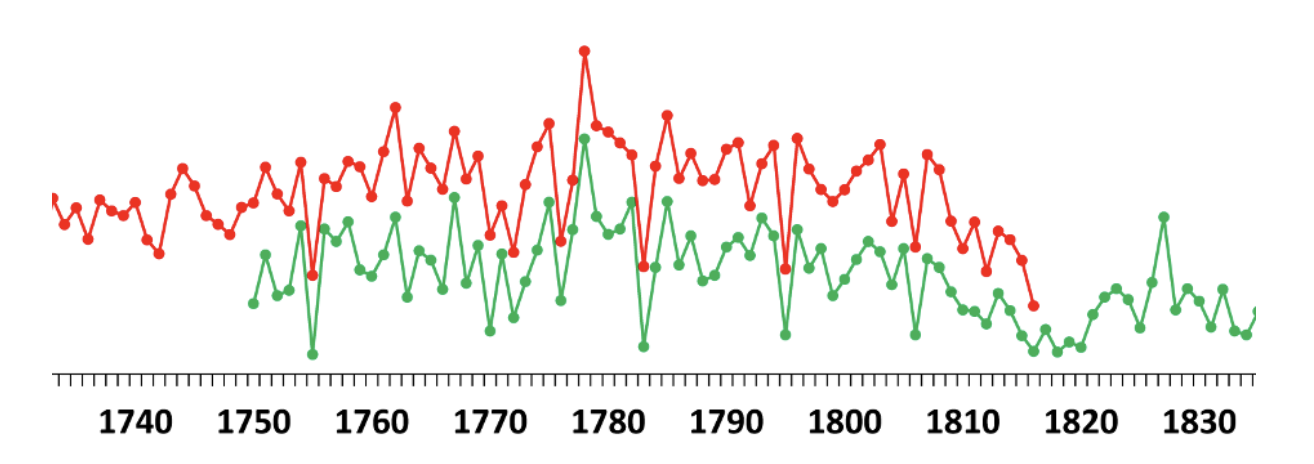
Cross-dating. The green graph is the width of the tree rings that have already been dated. The red graph is the width of the tree rings of an unknown tree. By comparing the places where the tree ring pattern is repeated, you can get a curve that covers a longer period of time than for each tree individually.
Cold, cold summer
If you look at the pattern a little more closely, you can see not only the years the tree has lived through but also the climatic adversities that occurred during its life. What if the tree was covered in frost?
Each ring contains echoes of the conditions and events of the period when it appeared. The same width of the rings can be used as a sensor of the summer temperature of past years: tree rings, almost like the liquid in a thermometer, seem to expand in a warm summer and contract in a cold one. It is also noticeable to the naked eye that the rings have different colors: some are darker, and some are lighter. The color, or rather the density of the rings is determined by the thickness of the cell walls of the tracheids.
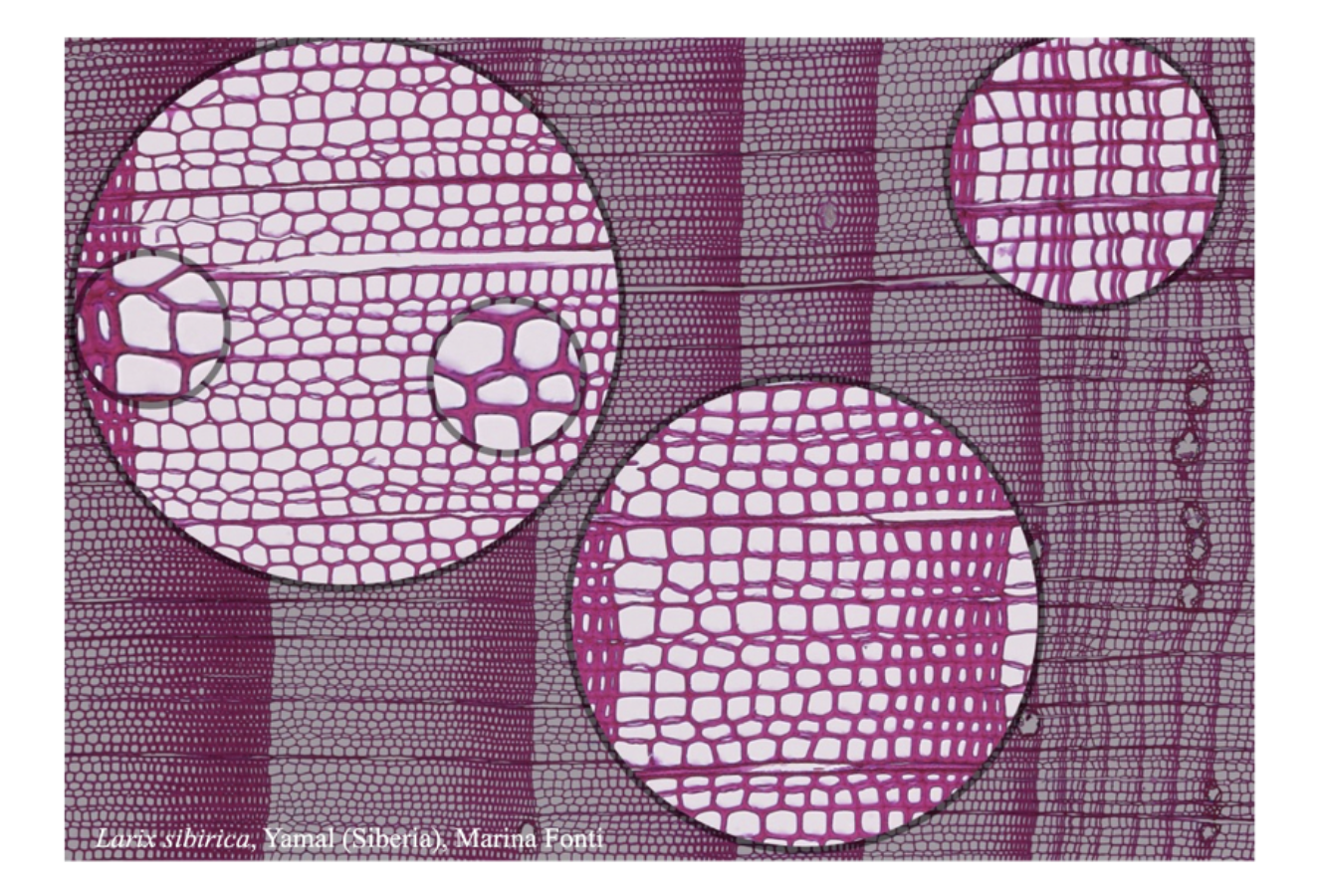
Micrograph of annual rings of larch (Larix sibirica). It is evident that the thickness of the cell wall of the last row varies in different rings: in the small circle in the upper right corner are rings with thin walls, in the large circles are rings with thick walls. Fonti et al. / Frontiers in Plant Sciences, 2025
By the thickness of the cell wall of the last row of tracheids, that is, by the color of the ring, it is possible to reconstruct the summer temperature with much higher quality than by the width of the rings. In addition, the density of the ring reflects the temperature of a longer period of the year — because the cell wall in a warm year continues to thicken until about September, that is, after the annual rings stop growing in width. The growth of the tracheid walls almost perfectly coincides with the course of the temperature of these months. If the second half of the summer is cold, the cells of the latewood tracheids practically do not thicken the cell wall — and the ring looks light.
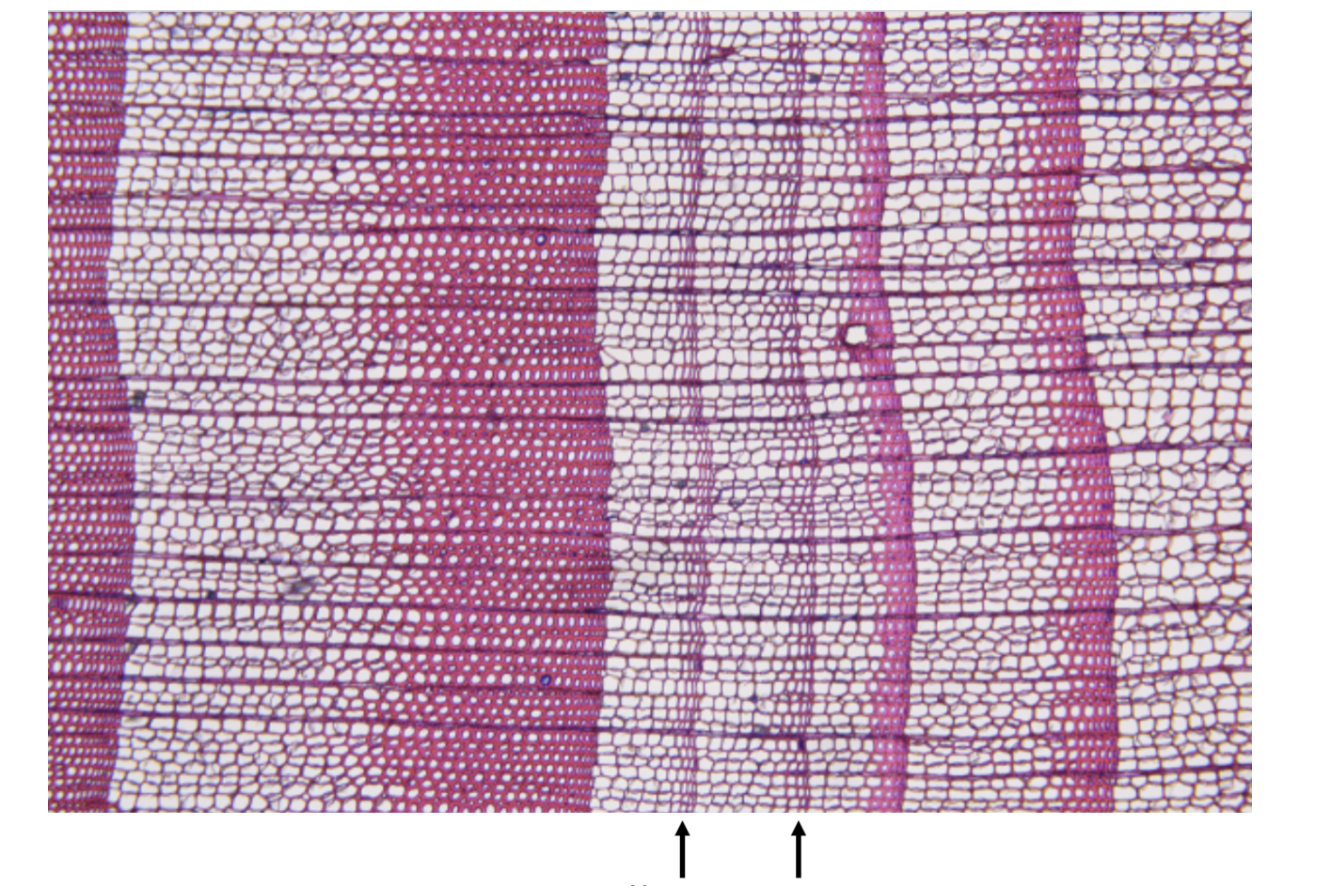
Two light rings in larch wood in Yamal. The summers of 536 and 537 were cold. Buntgen et al. / Science Bulletin, 2022
Light and other abnormal rings can be used to reconstruct extreme weather events — those that do not occur every year. For example, if frost suddenly decided to wrap up the tree not in winter, but in the middle of summer. The most specific, but very rare anomaly is a frost ring. When the temperature drops very sharply and significantly in summer, the living cells of the forming wood are damaged, and a characteristic scar appears on the annual ring.
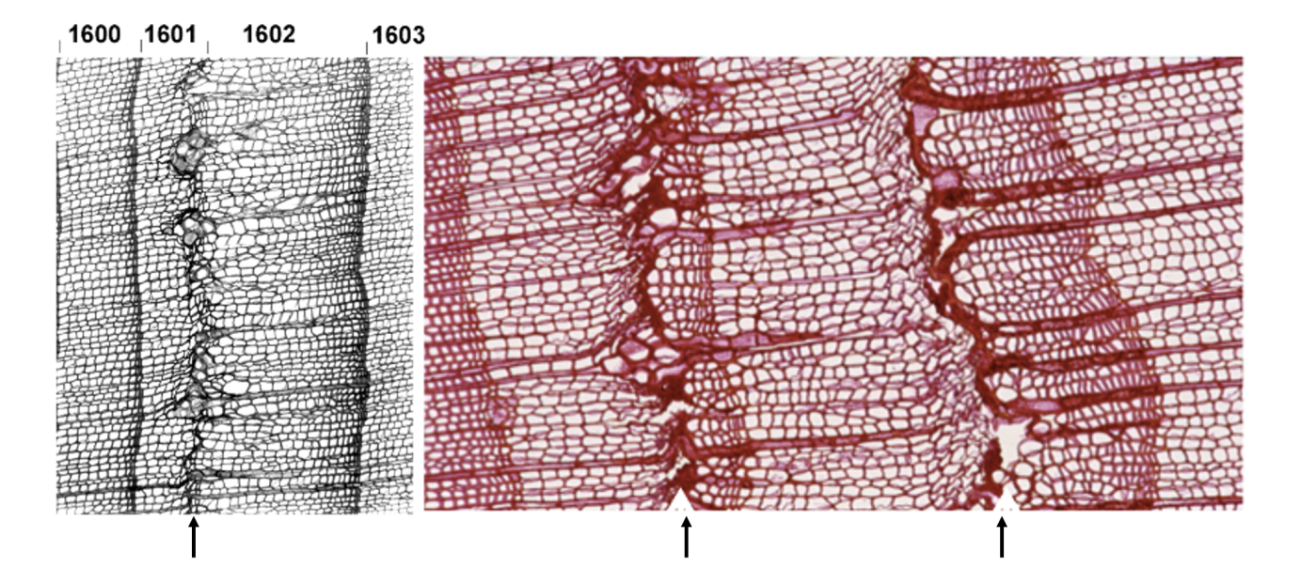
On the left is a frost ring of juniper (Juniperus communis) from 1601, the result of the eruption of the Huaynaputina volcano in 1600. On the right are frost rings of larch (Larix sibirica). Frost rings are indicated by arrows. Fritz Schweingruber
Volcanic winter
However, extreme temperature drops that lead to the formation of abnormal annual rings may occur not only due to local weather variability. They are often a reflection of global cataclysms.
One of the troubles that our Christmas tree could have experienced in its lifetime was a volcanic eruption. During large eruptions, volcanic gases and ash cover the Earth’s stratosphere with a dense blanket. Due to the ejected mixture of sulfur gases and ash, the sun’s radiation is screened by the atmosphere — and the temperature drops. Such a climatic anomaly is called a volcanic winter. Perhaps the most famous volcanic cooling occurred after the eruption of Mount Tambora in 1815. Unusually cold weather in Europe and North America became known as the year without a summer.
The eruption of Mount Tambora, like other large eruptions, left traces in the annual rings of trees. When you cut a tree that had to grow in a volcanic winter, you can see that the rings become narrow and light due to the colder climate, and frost and other abnormal rings appear.
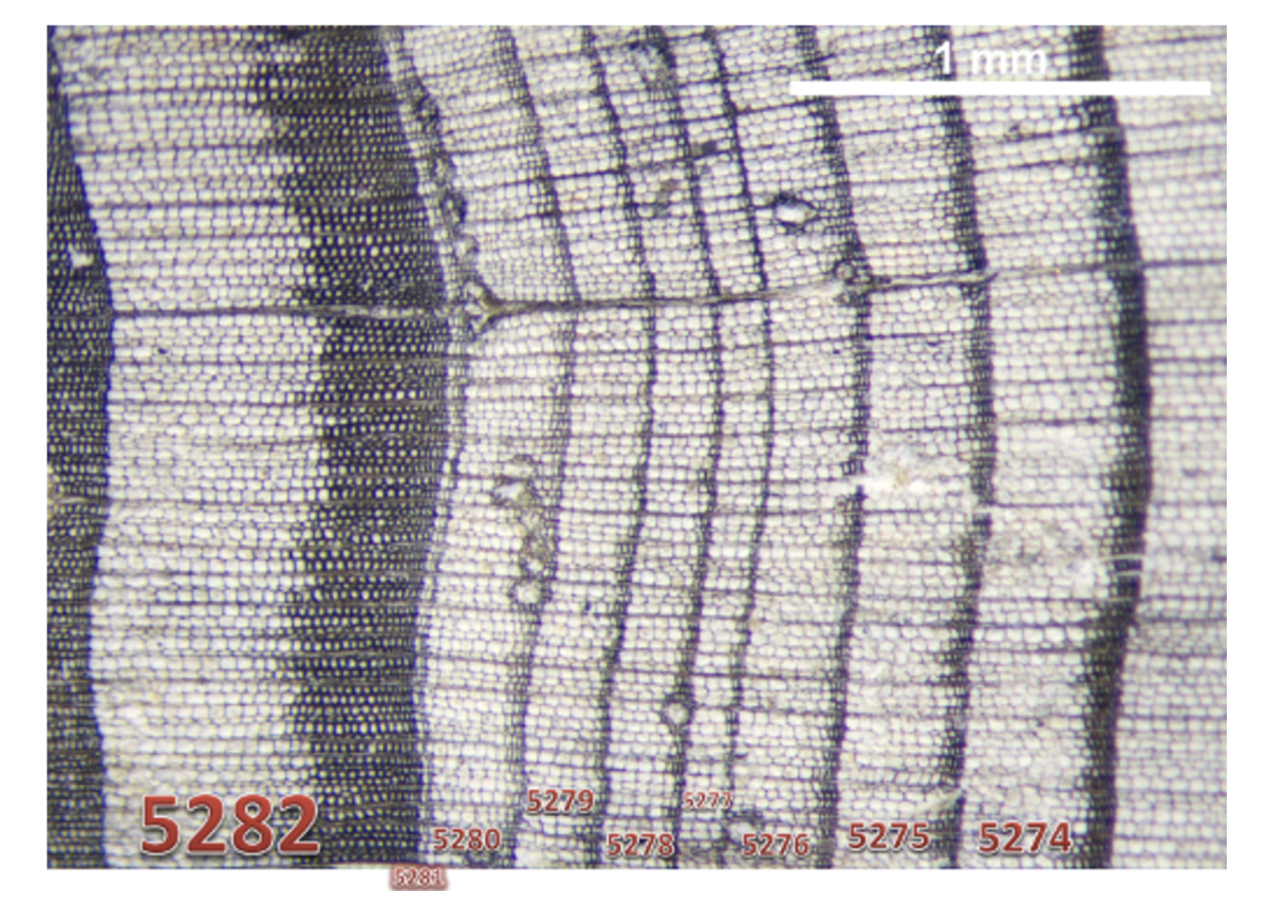
After 5282 BC, a decrease in growth, the formation of light rings, and pathological resin passages is noticeable. All this is a consequence of the sharp deterioration of conditions in Yamal after the eruption of the Kikai volcano. Bessonova et al. / Dendrochronologia, 2024
However, to be sure that the appearance of anomalous annual rings is associated with a volcanic eruption, and not just a cold snap, we have to look for additional confirmation. For example, some ancient eruptions are known from the traces they left in the ice sheets of Greenland and Antarctica. Ice is formed from compressed layers of snow, with the underlying layers being older than those that are higher. Each layer seals various inclusions: dust, ash, sulfate aerosols, radioactive substances, and air bubbles. These inclusions help to learn about the climate, the state of the atmosphere, and the volcanic activity of the past.
A combination of two methods — dendrochronology and glaciology — made it possible to establish the exact date of the eruption of the Kikai-Akahoya volcano, the most powerful in the last ten thousand years. According to the tree rings of a semi-fossil tree, the climatic consequences appeared in 5281 BC. This means that the eruption itself occurred a couple of years earlier.
Stellar flares
It turns out that terrestrial events, from cool summers to volcanic winters, can be seen with the naked eye on a Christmas tree. But a smart Christmas tree can hide another secret — traces of cosmic anomalies.
Using accelerator mass spectrometry, the content of radioactive carbon-14 can be studied in tree rings: a spike in its content will appear in some annual rings. In honor of the author of the article, who first described this phenomenon, as well as similar spikes discovered later, they began to be called Miyake events.
The causes of Miyake events are solar superflares. During flares, high-energy particles, most often protons, collide with atoms of gas molecules in the atmosphere of our planet, generating neutrons. When a neutron collides with a nitrogen atom in the atmosphere, radioactive carbon is produced. Cosmogenic carbon accumulates in tree rings, and thus Earth’s trees become a chronicle of the outbursts of the star closest to us.
Which trees are best suited for such studies? Due to the peculiarities of the Earth’s magnetic field, circumpolar trees respond to the effects of solar superstorms most clearly and with the least delay. Therefore, projects to study Miyake events over the past ten thousand years primarily rely on the use of subarctic trees, mainly from the Yamal Peninsula.

Carbon-14 content in tree rings aged 770–780 (left) and 990–1000 (right) in the northern (blue) and southern (red) hemispheres. Thin lines represent individual trees, thick lines represent the standard deviation from the hemisphere average. Büntgen et al. / Nature Communications, 2018
By now, reports have been published about a couple dozen Miyake events. Eight can be considered reliably established. It is unlikely that any of the fir trees that were at the New Year’s celebration of 2025 managed to catch one or more of the known Miyake events because even the most recent of them occurred in 994. But a long time ago, someone really could have brought a tree from the forest with an echo of super-powerful solar flares. For example, the Vikings cut down a fir tree (or rather, a fir and juniper) in 1021. True, to build a house, and not for the New Year’s celebration
So, if you look closely, the life of a Christmas tree often turns out to be much more complicated than a song: a Christmas tree was born in the forest, it grew in the forest, and all around there were unexpected frosts, volcanoes rumbled, and the Sun exploded in the sky.
illuminem Voices is a democratic space presenting the thoughts and opinions of leading Sustainability & Energy writers, their opinions do not necessarily represent those of illuminem.






